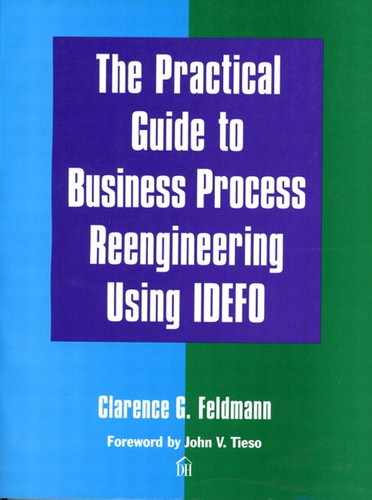Foreword
Over the past several years as I have traveled just about everywhere to discuss business reengineering, it has amazed me that most people think reengineering is a new phenomenon created by Mike Hammer. Some have been dumbfounded when I say how long it has been around and what it has accomplished during that time. I certainly give credit to Dr. Hammer’s book for the publicity reengineering has received, but it is the unsung heroes that have made reengineering not just well known but successful.
One such hero is Clare Feldmann. He and I have been talking about and through his book for at least five years. Clare is one of those guys who prefers the background to the limelight. His years at SofTech with Doug Ross were the tough years as reengineering emerged into a modern method. More importantly, Clare was one of the pioneers in the belief that understanding processes and activities is the key to the application of technology to problems. This book shares with you many of his thoughts on how to effectively reengineer.
I will share one personal insight for you to bear in mind as you read the chapters that follow. Over the years, Clare and I have shared a number of opportunities, committees, boards, and so forth. At each, he takes very careful notes. In fact, more often than not, he converts them to IDEFO activity diagrams and data diagrams. He has always claimed that he understands subjects better through models. By this time, he must have thousands of them. While I have no secret knowledge here, I will bet that a model exists for how to write a book. Ask him when you meet him.
Clare’s love of models led to a deep understanding of how processes work. A lot of what we now say and do in reengineering efforts comes from that approach: Understand what you do now and look at what you can do to improve the process. When you model the reengineered process, it quickly becomes obvious how technology can help to further optimize the efficiency of the new process. All of this is quite logical—yet completely impossible to achieve without models. Clare’s favorite technique is shown here—IDEFO—the integrated definition language that he helped create in the 1970’s. That modeling technique captures information not obtainable otherwise. Understanding the controls on actions as well as the mechanisms that facilitate action is critical to creating business rules that clarify action.
Another benefit of Clare’s effort is the timing. For those of us in Government, rapid change is upon us. The Information Technology Management Reform Act of 1996 now mandates that managers redesign processes before recommending information technology investments. In fact, this is a first step in bringing accountability to the hundreds of billions of dollars expended each and every year on technology in Government. With IDEFO, Clare shows managers a proven way to assure that those investments make sense.
Any time someone writes a book on reengineering, I cheer. Particularly so when the person writing the book has gotten his hands dirty with real work, in helping managers improve. We have too many volumes out there that discuss others’ efforts, written by people who have never tackled a project themselves. Here you have a master who is describing his art—and the only charge for his services is the cost of the book. What a bargain!
If you only have time to read one book on the subject, this is it. Enjoy.
John V. Tieso
Former Deputy Director, Office of Functional Process Improvement
Office of the Assistant Secretary of Defense (OASD)for Command and Control, C3I
Arlington, Virginia
